Teacup microdroplets and colours - OPOD
Teacup Microdroplets and Colors - Exploring the Fascinating Phenomenon
Have you ever noticed the mesmerizing display of colors on the surface of your tea or coffee when the sun hits it just right? These vibrant hues that dance and flicker before your eyes are caused by teacup microdroplets. Although they may appear small, they are still visible to the naked eye. In this article, we will delve into the world of teacup microdroplets and explore the intricate details of this captivating atmospheric optics phenomenon.
When observing a cup of hot tea or coffee, especially during the early morning or late afternoon when the sun is low, you may notice a stunning array of iridescent colors on the liquid's surface. These colors seem to shift and change, creating a captivating display that is both fleeting and enchanting. Some of these colors appear as grainy specks, while others are intensely bright and vivid. As you continue to gaze at the liquid's surface, you may even notice colors coiling upwards, evoking images of ice floes with cracks.
But what exactly causes these mesmerizing colors? The answer lies in the formation of triangular grids of microdroplets on the surface of the liquid. Through the use of microscopy and high-speed video, scientists have discovered that these microdroplets are approximately 20 microns in diameter, around 1/50th of a millimeter. Interestingly, their size decreases as the temperature of the liquid cools. These droplets arrange themselves in triangular patterns, with a higher density of droplets forming in hotter liquids.
However, what makes these microdroplets even more fascinating is that they do not rest directly on the surface of the liquid. Instead, they levitate approximately 0.5 to 5 times their own diameter above the liquid's surface. The exact mechanism behind this levitation is still not fully understood, but several theories have been proposed. One possibility is that the upward flow of vapor from surface evaporation supports the droplets. Another theory suggests that aerodynamic and surface tension effects on spinning drops could be responsible for their levitation. Additionally, the droplets and the tea surface may be charged, with electrostatic repulsion holding the droplets in their levitated state and accounting for their alignment into triangular arrays.
To further investigate the nature of these microdroplets, experiments have been conducted using tea with added salt to render the liquid conducting and reduce any surface charge. Surprisingly, salty tea did not exhibit the formation of microdroplet floes. However, this does not provide conclusive evidence for electrostatic levitation, as the salt may have other effects on the system. It's worth noting that traditional Mongolian Suutei tsai, which is tea with milk and salt, does not form droplet floes either.
The levitating drop arrays on the liquid's surface appear stable until one of the droplets suddenly disappears. This disappearance triggers a chain reaction, resulting in a catastrophe that spreads outward in a wave-like pattern. The surrounding drops vanish within a fraction of a second, causing entire floes to disappear, and cracks to form and propagate. The exact reason why the disappearance of a single droplet affects the entire floe so dramatically is still unknown. It is speculated that when a droplet falls to the liquid's surface, it creates a shallow wave that engulfs the surrounding drops, leading to their disappearance. However, more research is needed to fully understand this phenomenon.
Now, let's turn our attention to the captivating colors that adorn these microdroplet floes. Above the arrays of levitating droplets, you may notice sheets and coils of "steam" - droplets condensed out of the rising water vapor as it mixes with air and cools. These steamy coils are renowned for their shifting iridescent colors, which are caused by the diffraction of light as it interacts with the droplets. The iridescence of these coils resembles that of skyborne clouds but with greater vivacity and grace.
However, understanding the colors exhibited by the microdroplet floes themselves is a more complex endeavor. The shifting patterns and coherence of color across several floes suggest a connection between the motion and colors of the overlying vapor coils. It is unclear whether the same liquid convection patterns structure both the floes and the upward vapor streams or if some of the apparent floe iridescence originates from the vapor coils.
There are several mechanisms that can contribute to the coloration of the floe droplets. Firstly, the droplets themselves can directly diffract light, creating vivid and regular color patches. Alternatively, the coloration may involve reflection from the water beneath the droplets, resulting in a similar diffraction effect. Another possibility is the presence of Qu�telet colors, which occur when waves scatter both direct light and light reflected upwards from the tea, overlapping and interfering to produce a colored diffraction pattern. The quasi-regular triangular droplet arrays may even act as diffraction gratings, especially when the droplets are closer together in hotter tea.
The study of teacup microdroplets and their mesmerizing colors presents a rich field for further research. Through the use of video and high-speed imaging, scientists hope to uncover more insights into this captivating phenomenon. So, the next time you find yourself gazing into your teacup or coffee mug, take a moment to appreciate the intricate beauty that lies within these tiny droplets and their ever-changing colors.
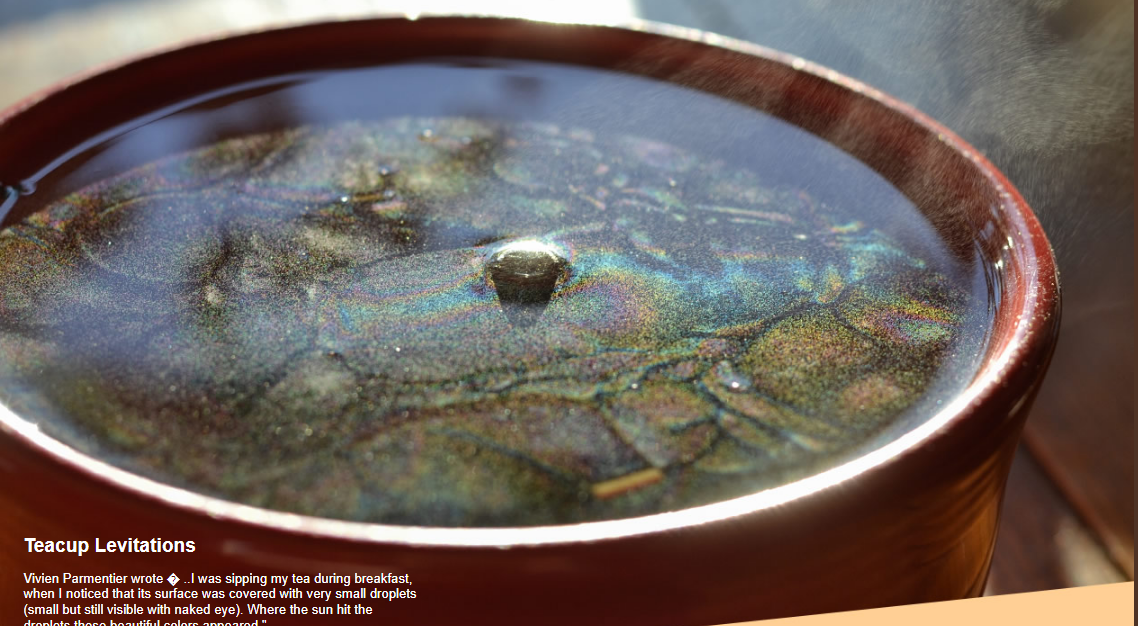
Teacup Levitations
Vivien Parmentier wrote � ..I was sipping my tea during breakfast, when I noticed that its surface was covered with very small droplets (small but still visible with naked eye). Where the sun hit the droplets these beautiful colors appeared."
Images ©Vivien Parmentier unless otherwise credited
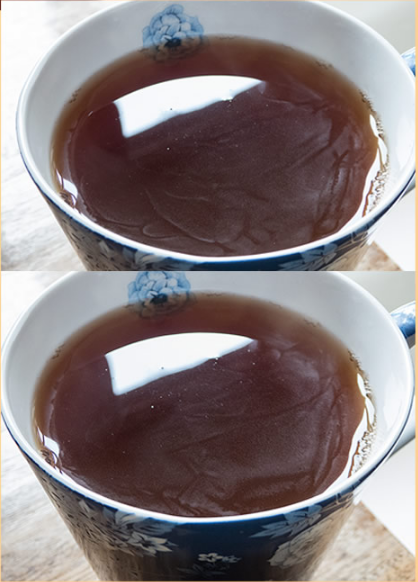
The ice floes and cracks on a cloudy English afternoon.
They look granular.
They constantly change, These images are 4s apart.
An area at a floe edge suddenly disappears. The catastrophe spreads as a crack. Sometimes An entire floe can vanish in an eye's blink.
Image ©Les Cowley
Look for them in hot tea or coffee (no milk) or indeed just hot water. Best when the sun is low. View the liquid at a low angle. Iridescent colours shift and dance, flicker, they are gone, then come again. Some are merely grainy, others intensely bright specks. There is colour on the surface, there is colour coiling upwards.
In shade, when colours are largely gone, the surface seems to have a skin. A 'skin' ever changing. It evokes ice floes with cracks (leads, the curse of early Arctic explorers) of clear water between. The cracks open and extend. Floe edges explode, disappear. All is change.
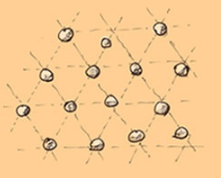
Microdroplets form triangular grids
The Floes
Given the ubiquity of tea and coffee cup gazing, there has been surprisingly little curiosity about the true nature of the 'skin'. Now, microscopy and high speed video have revealed that it is stranger than we might imagine. The skin is a layer of tiny similar sized droplets around 20 micron (1/50 mm) diameter. Their size decreases as the tea cools. They align themselves in triangular patterns clustering more densely the hotter the liquid.
But the droplets are not on the surface. They levitate some .5 to 5 drop diameters above it. The upward flow of vapour from surface evaporation might support them. Or aerodynamic and surface tension effects on spinning drops could do so. The droplets and tea surface could be charged and the drops held up by electrostatic repulsion. That would also nicely account for their alignment into arrays.
I tried making tea with an added teaspoon of salt to render the liquid conducting and reduce any surface charge. Salty tea had no floes. On its own, though, that�s not conclusive evidence for electrostatic levitation. The salt could have other effects.
Salt in tea? Traditional Mongolian Suutei tsai is tea with milk and salt. Does it have droplet floes?
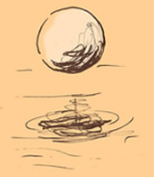
They levitate 0.5 to 5 drop diameters above the tea
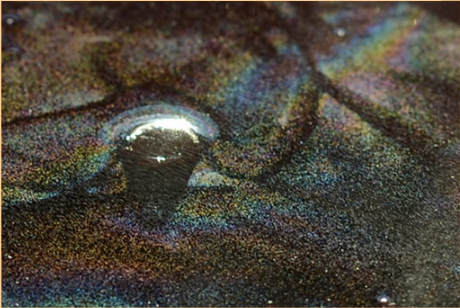
And the cracks?
The levitating drop arrays are stable until just one of them disappears. It�s not known to where. Then there is catastrophe. The drop's demise spreads outward wave-like. Surrounding drops disappear too in a fraction of a second. Entire floes vanish, cracks formed and propagate. The crack locations and the initial drop deaths might relate to the tea liquid convection patterns.
Why does a single droplet death afflict the floe so? It might fall to the liquid and create a shallow wave that engulfs the surrounding drops. The spread is actually at the speed of surface capillary waves. But more research is needed for the drops might sweep upwards instead.
Amazing behaviour raising many more questions about our everyday drinks.
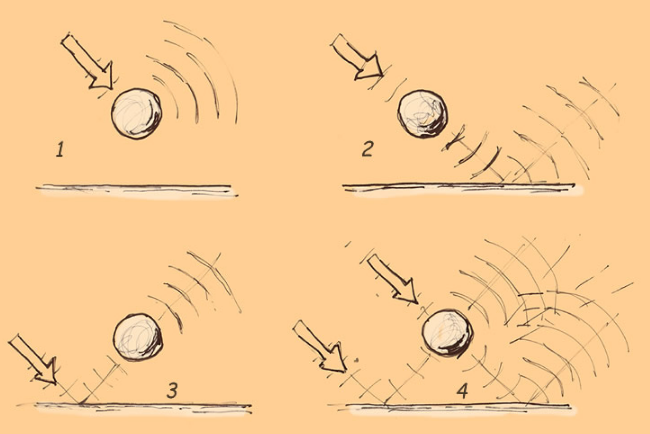
The colours
Above the arrayed droplets floes are the sheets and coils of ‘steam’ – droplets condensed out of the rising water vapour evaporate as it mixes with air and cools.
The steamy coils famously give shifting iridescent colours. Their drops diffract light to give the iridescence of sky borne clouds but with greater vivacity and grace.
The floe colours are harder to fathom. There is sometimes a temporal and spatial coherence of colour across several floes. The shifting patterns suggest the motion and colours of the overlying vapour coils. How are floes and upward vapour streams related? Does the same liquid convection pattern structure both? Or is some of apparent floe iridescence from the vapour coils?
Floe droplets themselves can diffract light either directly (1) or involving reflection from the water beneath (2)(3). Their similar sizes and high concentration will generate vivid and regular colour patches.
Qu�telet colours are an extra possibility (4). Waves scatter both from direct light and that reflected upwards from the tea. They overlap and interfere to give a coloured diffraction pattern.
The quasi-regular triangular droplet arrays might even act as diffraction gratings. That is especially so in hot tea when the droplets are closer together.
Many possibilities. Much scope for more teatime gazing laced with video and even high speed video.

Further reading:
Dynamics of microdroplets over the surface of hot water
Takahiro Umeki, Masahiko Ohata, Hiizu Nakanishi, Masatoshi Ichikawa
Scientific Reports (Nature) 5 (2015) 8046
A thanks to Vivien Parmentier for her photography and literature
research
Note: this article has been automatically converted from the old site and may not appear as intended. You can find the original article here.
Reference Atmospheric Optics
If you use any of the definitions, information, or data presented on Atmospheric Optics, please copy the link or reference below to properly credit us as the reference source. Thank you!
-
<a href="https://atoptics.co.uk/blog/teacup-microdroplets-and-colours-opod/">Teacup microdroplets and colours - OPOD</a>
-
"Teacup microdroplets and colours - OPOD". Atmospheric Optics. Accessed on December 22, 2024. https://atoptics.co.uk/blog/teacup-microdroplets-and-colours-opod/.
-
"Teacup microdroplets and colours - OPOD". Atmospheric Optics, https://atoptics.co.uk/blog/teacup-microdroplets-and-colours-opod/. Accessed 22 December, 2024
-
Teacup microdroplets and colours - OPOD. Atmospheric Optics. Retrieved from https://atoptics.co.uk/blog/teacup-microdroplets-and-colours-opod/.